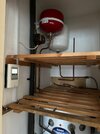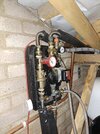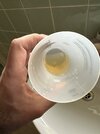- Joined
- 24 Dec 2023
- Messages
- 8
- Reaction score
- 0
- Country

Hi - first post but thought it was the right place to canvas opinion as I always find myself on here when doing various DIY jobs!
I’ve just moved into a house with what I thought was a functioning solar thermal set up. I had no history of the set up when I got the house as the former owner had passed away, and I also had never even seen a set up before so am a complete novice when it comes to solar thermal. The pressure gauge on the system was reading zero and rose slightly when the sun came out and the system started circulating. As such I called a local solar company to come and have a look. He wasn’t willing to do anything to it given the incorrect spec of the set up.
The main problems are:
- Normal central heating pump
- Normal expansion vessel
- No flush/fill valve
- 15mm pipe from the HW cylinder to the pump and part way to the collector, then 10mm for the remainder.
- No pumping station
I think basically my options are
1. Drain it down and turn it off
2. Fit a flush/fill valve, hire a pump and have a go at flushing and refilling it and just let it run until it packs up completely.
3. Buy a solar rated pump/expansion vessel and upgrade the piping to 22mm throughout.
Obviously the costs increase at each level so I’m just wondering what people’s thoughts are and whether anyone has come across anything similar! I’ve added a few pictures but if anyone wants specifics let me know!
Thanks in advance!
I’ve just moved into a house with what I thought was a functioning solar thermal set up. I had no history of the set up when I got the house as the former owner had passed away, and I also had never even seen a set up before so am a complete novice when it comes to solar thermal. The pressure gauge on the system was reading zero and rose slightly when the sun came out and the system started circulating. As such I called a local solar company to come and have a look. He wasn’t willing to do anything to it given the incorrect spec of the set up.
The main problems are:
- Normal central heating pump
- Normal expansion vessel
- No flush/fill valve
- 15mm pipe from the HW cylinder to the pump and part way to the collector, then 10mm for the remainder.
- No pumping station
I think basically my options are
1. Drain it down and turn it off
2. Fit a flush/fill valve, hire a pump and have a go at flushing and refilling it and just let it run until it packs up completely.
3. Buy a solar rated pump/expansion vessel and upgrade the piping to 22mm throughout.
Obviously the costs increase at each level so I’m just wondering what people’s thoughts are and whether anyone has come across anything similar! I’ve added a few pictures but if anyone wants specifics let me know!
Thanks in advance!






